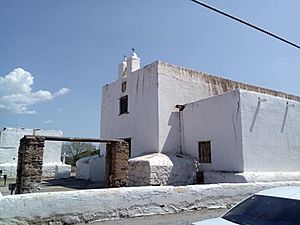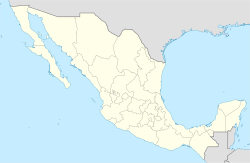Janos, Chihuahua facts for kids
Quick facts for kids
Janos
|
|
|---|---|

Franciscan mission in Janos, established in 1640
|
|
| Elevation | 1,357 m (4,452 ft) |
| Population | |
| • Total | 2,738 |
Janos is a town in northern Mexico. It is located in the Mexican state of Chihuahua. Janos is the main town for the Janos Municipality, which is the area around it. In 2010, about 2,738 people lived in Janos.
Janos might have been the site of a Franciscan mission. This mission was set up around 1640. Native American attacks destroyed it in the 1680s. In 1686, the Spanish built a fort in Janos. This fort was very important. It helped the Spanish try to stop attacks from the Apache people. Hundreds of Apaches often lived near this fort in the late 1700s and early 1800s.
History of Janos
In 1630, a Franciscan missionary named Alonso de Benavides wrote about the Janos and Suma tribes. He called them "fierce tribes." They lived along the travel route between Spanish settlements in Mexico and New Mexico.
In 1640, a mission was started for these Native American tribes. It was called Nuestra Señora de la Soledad de los Janos. The goal was to teach them about Christianity. We are not sure exactly where this first mission was. It might have been near the future town of Janos. Or it might have been near El Paso, Texas. In the 1680s, the Suma, Janos, and other tribes rebelled. They destroyed the mission. Another group, the Jocomes, also became important near Janos.
In 1686, the Spanish governor ordered Captain Juan Fernández de la Fuente to send soldiers to Janos. They were to build a presidio (a strong fort). It was named Presidio de San Felipe y Santiago de Janos. In 1717, the Franciscan mission was started again for the Janos and Jocomes people.
However, in 1692, a new group appeared in Mexico for the first time. These were the Apache people, who had moved from further north. Over time, the Suma, Janos, and Jocomes tribes slowly disappeared from Spanish records. They were likely absorbed by the Apaches. Some Suma people also became part of the Native American population in El Paso, Texas.
Apache Interactions
Janos was one of 18 forts built by the Spanish. Most of these forts were near what is now the border between Mexico and the United States. Their purpose was to protect Spanish settlements. They needed protection from attacks and raids by Apaches and later Comanches.
The Apaches had reasons for their anger. People from Spanish settlements and their Native American allies often captured and enslaved Apaches. This caused a lot of conflict. Janos was probably the most important of these forts. It eventually had 144 soldiers. It also had helpers from nearby Native Americans and civilians.
We don't have much information about the Janos fort before 1750. But in 1737, a Spanish writer mentioned how much damage Apache raids caused. Decades of Apache raids and Spanish counter-attacks reached a peak in the 1770s. In the region of Nueva Vizcaya (which is now Chihuahua and Durango states), many people died between 1771 and 1776. Over 1,600 Spanish people were killed, and 154 were captured. Also, 100 ranches were left empty, and 68,000 farm animals were stolen. Spanish expeditions, led by Hugo Oconór from Janos and other forts, fought back. They caused many Apache deaths.
Despite the problems with the Apaches, the town of Janos was founded around 1778. The number of people living there slowly started to grow. In 1807, a chapel called Nuestra Señora del Pilar was finished.
The Spanish began programs to make peace. In 1790, Apaches were invited to live in Janos. They received gifts of food and other supplies. By 1793, 368 Apaches were counted at Janos as "pacified" (meaning they were peaceful). This number changed over time, but usually stayed in the hundreds until about 1831.
To keep the peace, each Apache man received food every week. This included corn or wheat, cigarettes, brown sugar, and salt. They also got some meat when it was available. Chiefs received more sugar and cigarettes. Women and children received less food. Apaches could also find more food on their own. They also received clothes and other items they needed. The Spanish gave horses and other gifts to Apache leaders they favored.
In return, the Apaches were supposed to stop fighting. They were also expected to learn farming and grow crops. They were supposed to join Spanish groups that went to fight other Apaches. However, the years from 1790 to 1820 were mostly peaceful. A few Apaches became Christians. Some Apache women married Spanish men.
After Mexico became independent from Spain in 1821, more outsiders moved onto Apache lands. The practice of giving food to peaceful Apaches ended in 1831. Almost all the Apaches left the forts, including Janos. They went back to their traditional way of life, which included raiding. In 1858, the mother, wife, and three children of the Apache leader Geronimo were killed near Janos. This happened in an attack by Mexican soldiers from Sonora. Geronimo was in Janos trading with local merchants when this happened.
Geography and Climate
Janos has a semi-arid climate. This means it is quite dry. Winters are sunny, but temperatures often drop below freezing. The town might get snow 2 or 3 times a year. June is the warmest month. Most of the rain falls from July to October during the monsoon season. The hottest temperature ever recorded was 45.0°C (113°F) in August 1979. The coldest was -13°C (9°F) in December 1978.
| Climate data for Janos, Chihuahua, elevation 1,357 metres (4,452 ft) | |||||||||||||
|---|---|---|---|---|---|---|---|---|---|---|---|---|---|
| Month | Jan | Feb | Mar | Apr | May | Jun | Jul | Aug | Sep | Oct | Nov | Dec | Year |
| Record high °C (°F) | 26.0 (78.8) |
29.0 (84.2) |
31.0 (87.8) |
36.0 (96.8) |
40.0 (104.0) |
42.0 (107.6) |
40.0 (104.0) |
45.0 (113.0) |
40.0 (104.0) |
36.5 (97.7) |
30.0 (86.0) |
26.0 (78.8) |
45.0 (113.0) |
| Mean daily maximum °C (°F) | 14.2 (57.6) |
16.7 (62.1) |
19.5 (67.1) |
23.1 (73.6) |
27.3 (81.1) |
31.5 (88.7) |
30.1 (86.2) |
30.1 (86.2) |
27.1 (80.8) |
22.7 (72.9) |
18.0 (64.4) |
14.6 (58.3) |
22.9 (73.2) |
| Daily mean °C (°F) | 7.1 (44.8) |
8.8 (47.8) |
11.1 (52.0) |
14.3 (57.7) |
18.2 (64.8) |
22.3 (72.1) |
22.3 (72.1) |
22.1 (71.8) |
19.4 (66.9) |
14.7 (58.5) |
10.1 (50.2) |
7.4 (45.3) |
14.8 (58.6) |
| Mean daily minimum °C (°F) | −0.1 (31.8) |
0.9 (33.6) |
2.8 (37.0) |
5.4 (41.7) |
9.0 (48.2) |
13.2 (55.8) |
14.5 (58.1) |
14.1 (57.4) |
11.6 (52.9) |
6.6 (43.9) |
2.1 (35.8) |
0.2 (32.4) |
6.7 (44.1) |
| Record low °C (°F) | −10.0 (14.0) |
−7.5 (18.5) |
−7.0 (19.4) |
−11.5 (11.3) |
−7.0 (19.4) |
2.0 (35.6) |
2.0 (35.6) |
2.0 (35.6) |
1.0 (33.8) |
−4.0 (24.8) |
−12.0 (10.4) |
−13.0 (8.6) |
−13.0 (8.6) |
| Average precipitation mm (inches) | 15.3 (0.60) |
11.6 (0.46) |
11.0 (0.43) |
7.1 (0.28) |
5.8 (0.23) |
16.7 (0.66) |
73.8 (2.91) |
58.6 (2.31) |
46.3 (1.82) |
29.5 (1.16) |
15.5 (0.61) |
21.5 (0.85) |
312.7 (12.31) |
| Average precipitation days (≥ 0.1 mm) | 3.0 | 2.0 | 2.0 | 1.2 | 1.0 | 1.8 | 9.1 | 7.2 | 5.2 | 3.3 | 2.1 | 3.4 | 41.3 |
| Average snowy days | 0.60 | 0.50 | 0.30 | 0.05 | 0 | 0 | 0 | 0 | 0 | 0 | 0.31 | 0.57 | 2.33 |
| Source 1: Servicio Meteorológico Nacional | |||||||||||||
| Source 2: Colegio de Postgraduados (snowy days) | |||||||||||||
See also
 In Spanish: Janos para niños
In Spanish: Janos para niños


